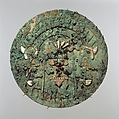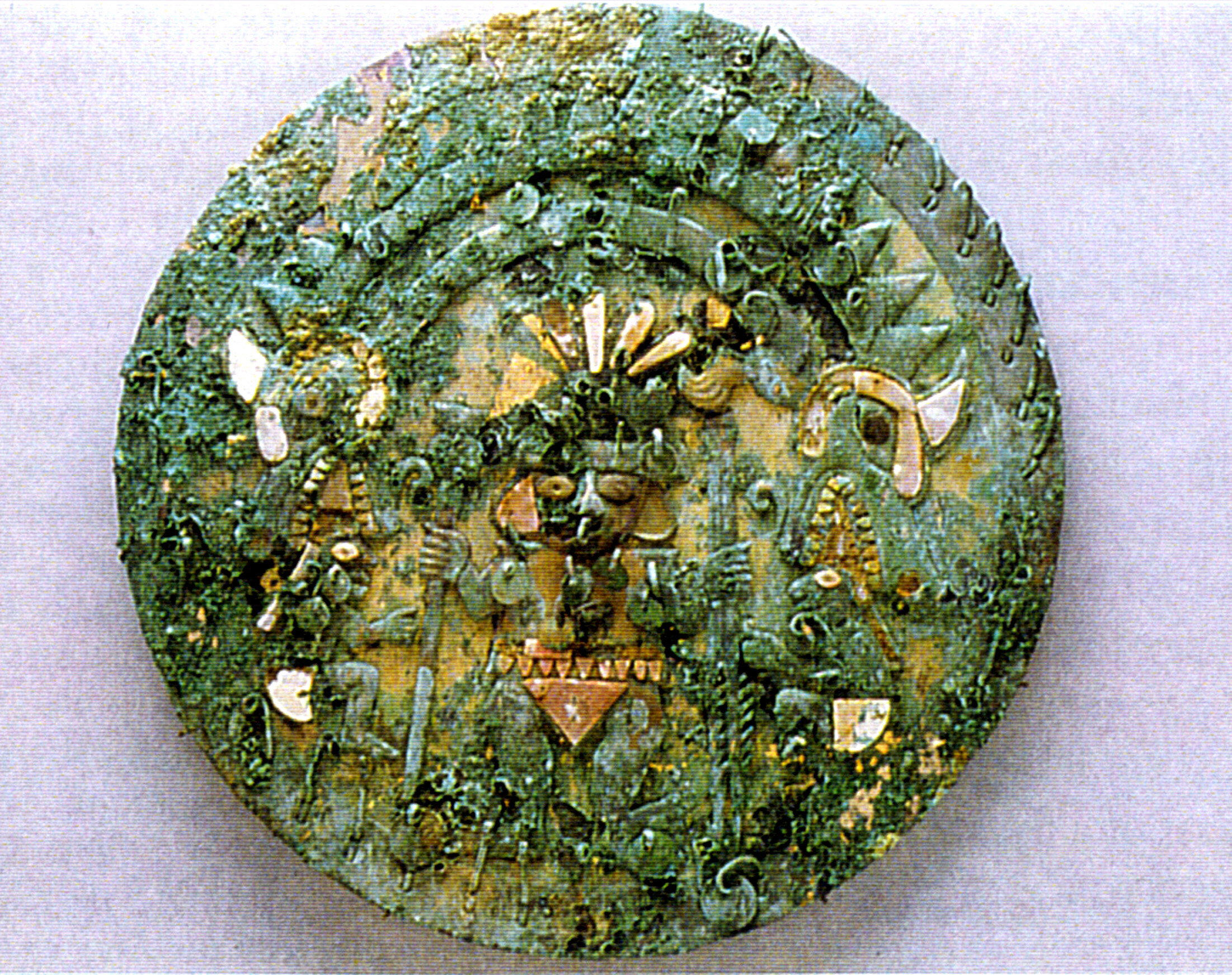Disk with Figure
Not on view
This magnificent silvered and gilded copper disk was produced by metal workers of the Moche culture on the North Coast of Peru. A gilded backing disk, cut from a larger sheet, supports a figure of a warrior under a double-headed serpent-like creature, which holds in each mouth a small crouching profile figure by the hair. All four figures, warrior, serpent, and victims, as well as the border of the disk, were formed from separate pieces of silvered copper affixed to the backing with tabs, creating an overall composition of silvered figures and outer margin against a gold background.
The central figure is embellished with a metal crescent dangle suspended from the nose and a triangular headdress originally topped with five plumes, made of shell, two of which are missing. The warrior’s eyes and ears are also of shell - the inlay for the proper left ear has been lost. The figure has a shell loin cloth and a tunic embellished with a border of shell inlays. In his proper right hand, he holds a mace and in his left hand two barbed spears. The serpent-like creature, sometimes called a Moon Animal, has inlaid shell teeth, eyes, and semi-circle behind its two heads. The eye of each serpent head is turquoise. The nostrils were originally inlaid with shell or stone. Each serpent head has a small curl under the chin and the proper left figure has a small paw extending down behind the head; the paw on the proper right side is missing. The crouching figures’ hair and loincloths are also inlaid with shell. The figure on the proper left is missing its foot. Multiple dangles suspended from thin wires adorn the bodies of the central figure, serpent, victims, as well as the central figure’s headdress and the outer border of the disk. Numerous small shell beads are encased in the corrosion products on the surface of the disk, indicating that a beaded textile or ornament had been interred on top of this object. In its original state, this object must have radiated power and beauty with its contrasting colors of gold and silver combined with the shimmering motion of the dangles.
The function of disks such the present example is unclear. They may have served as shield frontals, attached to a cane backing, but the delicate nature of the design would have limited its protective function in actual battle. Thus, these objects may have been intended for ritual use as symbolic weapon adornments. Alternatively, they may have been attached to textile banners or hangings.
The Moche (also known as the Mochicas) flourished on Peru’s North Coast from 200-800 AD, centuries before the rise of the Incas. Over the course of some six centuries the Moche built thriving regional centers from the Nepeña River Valley in the south to perhaps as far north as the Piura River, near the modern border with Ecuador, developing coastal deserts into rich farmlands and drawing upon the abundant maritime resources of the Pacific Ocean’s Humboldt Current. Although the precise nature of Moche political organization is unknown, these centers shared unifying cultural traits such as religious practices (Donnan, 2010).
This object was said to have been found at the burial site of Loma Negra, which was one of the most northern outposts of Moche culture. Loma Negra works in metal share similar iconography with ceramics and metalwork found at Moche sites father to the south, such as Ucupe (Bourget, 2014). The exact relationship between the Loma Negra and the Moche “heartland” remains a subject of debate, however (Kaulicke, 2006).
Published References
Schorsch, Deborah, Ellen G. Howe, and Mark T. Wypyski, “Silvered and Gilded Copper Metalwork from Loma Negra: Manufacture and Aesthetics.” Boletin Museo del Oro vol.4 (1996), pp. 145-163.
Schorsch, Deborah. "Silver-and-Gold Moche Artifacts from Loma Negra, Peru." Metropolitan Museum Journal vol. 33 (1998).
References and Further Reading
Bourget, Steve. “Les rois mochica: Divinité et pouvoir dans le Pérou ancient.” Paris: Somogy éditions d'art; Geneva: MEG, Musée d'ethnographie de Genève, 2014.
Castillo, Luis Jaime. “Masters of the Universe: Moche Artists and Their Patrons.” In Golden Kingdoms: Luxury Arts in the Ancient Americas, edited by Joanne Pillsbury, Timothy Potts, and Kim N. Richter. Los Angeles: J. Paul Getty Museum, 2017, pp. 24-31.
Disselhoff, Hans-Dietrich. "Metallschmuck aus der Loma Negra, Vicus (Nord-Peru)." Antike Welt vol. 3 (1972), pp. 43–53.
Donnan, Christopher B. and Donna McClelland. “Moche Fineline Painting.” Los Angeles: Fowler Museum of Cultural History, University of California, Los Angeles, 1999. Donnan, Christopher B. “Moche State Religion.” In New Perspectives on Moche Political Organization, edited by Jeffrey Quilter and Luis Jaime Castillo. Washington D.C.: Dumbarton Oaks Research Library and Collection, 2010, pp. 47-69.
Jones, Julie. "Mochica Works of Art in Metal: A Review." In Pre-Columbian Metallurgy of South America, edited by Elizabeth P. Benson. Washington, D.C.: Dumbarton Oaks Research Library and Collection, 1979, pp. 53-104.
Kaulicke, Peter. “The Vicús-Mochica Relationship.” In Andean Archaeology III, edited by William H. Isbell and Helene H. Silverman. Boston, MA: Springer, 2006, pp. 85-111.
Lechtman, Heather, Antonieta Erling, and Edward J. Barry Jr. "New Perspectives on Moche Metallurgy: Techniques of Gilding Copper at Loma Negra, Northern Peru." American Antiquity vol. 47 (1982), pp. 3-30.
Schorsch, Deborah, Ellen G. Howe, and Mark T. Wypyski, “Silvered and Gilded Copper Metalwork from Loma Negra: Manufacture and Aesthetics.” Boletin Museo del Oro vol.4 (1996), pp. 145-163.
Schorsch, Deborah. "Silver-and-Gold Moche Artifacts from Loma Negra, Peru." Metropolitan Museum Journal vol. 33 (1998).
Due to rights restrictions, this image cannot be enlarged, viewed at full screen, or downloaded.
This artwork is meant to be viewed from right to left. Scroll left to view more.



